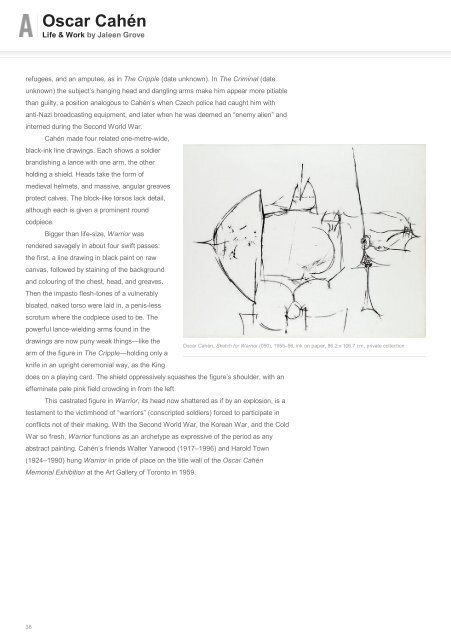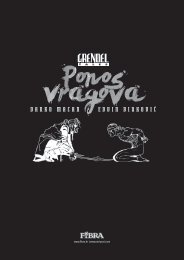Oscar Cahén
Art-Canada-Institute_Oscar-Cah%C3%A9n
Art-Canada-Institute_Oscar-Cah%C3%A9n
You also want an ePaper? Increase the reach of your titles
YUMPU automatically turns print PDFs into web optimized ePapers that Google loves.
<strong>Oscar</strong> <strong>Cahén</strong><br />
Life & Work by Jaleen Grove<br />
refugees, and an amputee, as in The Cripple (date unknown). In The Criminal (date<br />
unknown) the subject’s hanging head and dangling arms make him appear more pitiable<br />
than guilty, a position analogous to <strong>Cahén</strong>’s when Czech police had caught him with<br />
anti-Nazi broadcasting equipment, and later when he was deemed an “enemy alien” and<br />
interned during the Second World War.<br />
<strong>Cahén</strong> made four related one-metre-wide,<br />
black-ink line drawings. Each shows a soldier<br />
brandishing a lance with one arm, the other<br />
holding a shield. Heads take the form of<br />
medieval helmets, and massive, angular greaves<br />
protect calves. The block-like torsos lack detail,<br />
although each is given a prominent round<br />
codpiece.<br />
Bigger than life-size, Warrior was<br />
rendered savagely in about four swift passes:<br />
the first, a line drawing in black paint on raw<br />
canvas, followed by staining of the background<br />
and colouring of the chest, head, and greaves.<br />
Then the impasto flesh-tones of a vulnerably<br />
bloated, naked torso were laid in, a penis-less<br />
scrotum where the codpiece used to be. The<br />
powerful lance-wielding arms found in the<br />
drawings are now puny weak things—like the<br />
arm of the figure in The Cripple—holding only a<br />
knife in an upright ceremonial way, as the King<br />
does on a playing card. The shield oppressively squashes the figure’s shoulder, with an<br />
effeminate pale pink field crowding in from the left.<br />
This castrated figure in Warrior, its head now shattered as if by an explosion, is a<br />
testament to the victimhood of “warriors” (conscripted soldiers) forced to participate in<br />
conflicts not of their making. With the Second World War, the Korean War, and the Cold<br />
War so fresh, Warrior functions as an archetype as expressive of the period as any<br />
abstract painting. <strong>Cahén</strong>’s friends Walter Yarwood (1917–1996) and Harold Town<br />
(1924–1990) hung Warrior in pride of place on the title wall of the <strong>Oscar</strong> <strong>Cahén</strong><br />
<strong>Oscar</strong> <strong>Cahén</strong>, Sketch for Warrior (050), 1955–56, ink on paper, 86.2 x 106.7 cm, private collection<br />
Memorial Exhibition at the Art Gallery of Toronto in 1959.<br />
Multi-part Mural for Imperial Oil Executive Office Building 1956<br />
38



